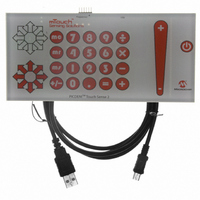DM164128 Microchip Technology, DM164128 Datasheet - Page 26

DM164128
Manufacturer Part Number
DM164128
Description
KIT DEV PICDEM TOUCH SENSE 2
Manufacturer
Microchip Technology
Series
mTouch™r
Specifications of DM164128
Sensor Type
Touch, Capacitive
Interface
Microprocessor
Embedded
Yes, MCU, 16-Bit
Utilized Ic / Part
PIC24F
Silicon Manufacturer
Microchip
Silicon Core Number
PIC24F256GB110
Features
ICSP Programming Capability, Directional Pad, Keypad And Slider Sensor
Kit Contents
Board
Lead Free Status / RoHS Status
Lead free / RoHS Compliant
Voltage - Supply
-
Sensitivity
-
Sensing Range
-
Lead Free Status / RoHS Status
Lead free / RoHS Compliant
Available stocks
Company
Part Number
Manufacturer
Quantity
Price
Company:
Part Number:
DM164128
Manufacturer:
Microchip Technology
Quantity:
135
PICDEM Touch Sense 2 Demo Board User’s Guide
DS51748A-page 22
4.2.1
The components listed here (in order of their reference tags in Figure 4-3) are the key
components of the application side of the Touch Sense 2 Demo Board:
1. PIC24FJ256GB110 Microcontroller (U1): This provides the processing power
2. USB mini-B Receptacle (J3): This provides a convenient interface to the
3. ICSP Header Interface (J1): This provides a standard Microchip ICD interface
4. Power Supply (D18/Q1): This converts the +5 V
5. Piezo Speaker (BZ1): This small form factor component provides audible
6. Directional Sensor LEDs (D19-24, D26-27, D38): These provide visual
7. Directional Touch Sensor (ROT1): The capacitive sensors are located in this
8. Numeric Keypad (S1-12, S21-28, D1-10, D28-37): This area contains the
9. Touch Slide (S14, D12-17, D39-64): This area contains the sensors for the
10. Power Touch Switch (S20, D65): This area contains the LED and sensor for the
for the Touch Sense demo applications. The microcontroller features 256 Kbytes
of Flash program memory and 16 Kbytes RAM, allowing sufficient space for the
development of more complex touch sense applications.
The demo application uses an 8 MHz signal to create the 48 MHz USB clock, as
well as the application’s 32 MHz clock. Crystal, Y1, and associated components
are used by the microcontroller’s internal oscillator to maintain the frequency
tolerances required by the USB specifications.
PC-side of the demo application. As the Touch Sense 2 Demo Board functions
as a bus-powered device, this connection also provides power to the board.
for programming and debugging applications on the Touch Sense 2 Demo
Board; it is designed to connect directly with Microchip’s PICkit™ Serial
Programmer. Pin 1 (N/C) is located on the right side of the interface, as viewed
from the front of the board, and is marked with an arrow.
An optional RJ-11 adapter (Microchip Part # AC164110, included with the Touch
Sense 2 Demo Board kit) can also be used for modular cable connections to both
the MPLAB ICD 2 Programmer/Debugger module and the MPLAB REAL ICE™
module. Switch S11 (to the left of the header) connects the PGD and PGC lines
of the interface with columns 3 and 4 of the keypad, which are also used as the
PGD and PGC pins of the microcontroller.
+3.3 V
Circuit traces in this area are also provided to create a non-USB power supply for
self-powered (freestanding) use. This power supply is designed to convert 9 VAC
to a regulated +3.3 V
the indicated locations with diode, D25, and voltage regulator, U5, as well as
capacitors, C14, C15, C16 and C17, and receptacle, J4. Specifications for these
components are provided in Appendix A. “Demo Board Schematics”.
feedback in the demo application.
feedback for touch events on the directional sensor pad.
area on the front side of the board (see Figure 4-2).
sensors and LEDs associated with the touch keypad. The capacitive touch
sensors are located on the front of the board (see Figure 4-2).
touch slide and the 32 LEDs comprising the continuous bar display. The
capacitive touch sensors are located on the front of the board (see Figure 4-2).
demo board’s “soft” power switch. The sensor is located in this area on the front
side of the board (see Figure 4-2).
Components
DC
required by the demo board.
DC
and +5 V
DC
. To implement, the user will need to populate
DC
from V
© 2008 Microchip Technology Inc.
BUS
to the regulated












